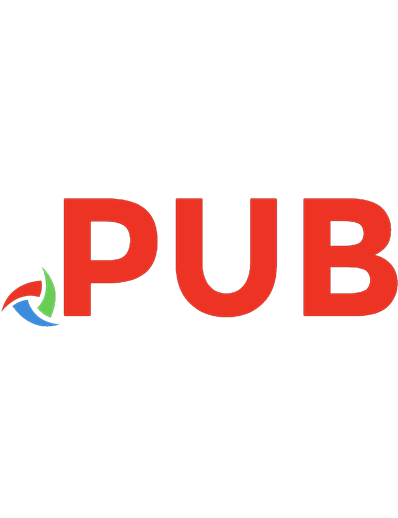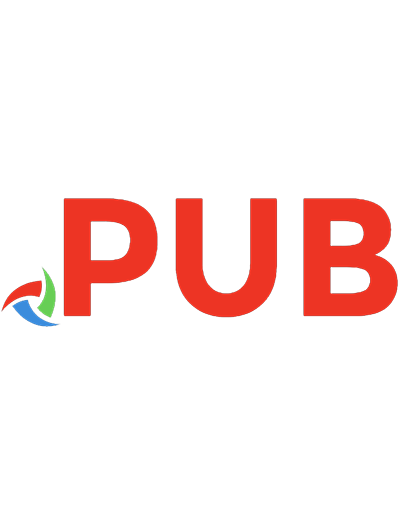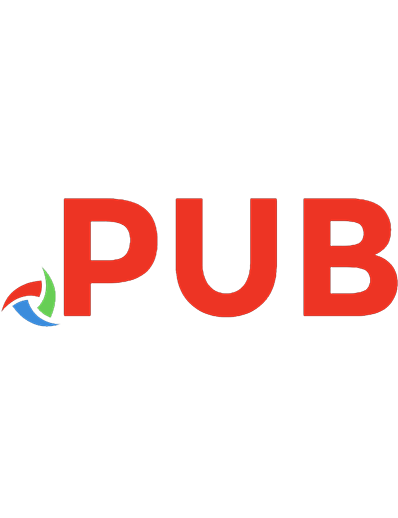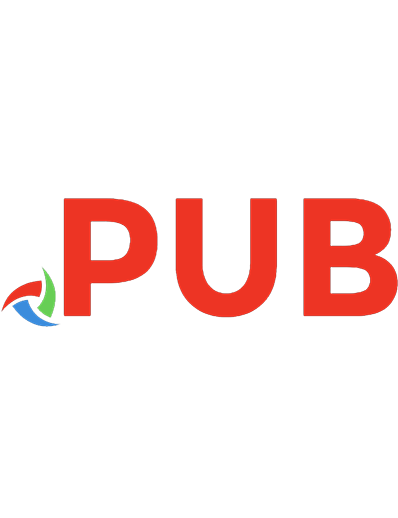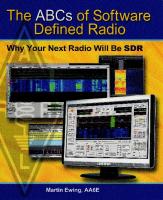Arrl’s abcs of sdr : Why your next radio will be software defined. 9780872596320, 087259632X
557 146 26MB
English Pages 63 Year 2012
Polecaj historie
Table of contents :
Machine generated contents note: ch. 1 It's a New World! --
ch. 2 The Meaning of "Digital" --
ch. 3 Real-World Software Defined Radio --
ch. 4 Computers and Software for SDR --
ch. 5 Using SDR --
ch. 6 Coming to a Shack Near You.
Citation preview
Why Yo ur Next Radio Will Be SDR
Production
Cover
Michelle Bloom, WB lENT Jod i Morin, KA IJPA David Pingree,N INAS
Sue Fagan, KB IOKW
Copyright © 2012 by The American Radio Relay League , Inc.
Copyright secured under the Pan-American Convention International Copyr ight secured All rights reserved. No part of this work may be reproduced in any form except by written perm ission of the publisher. All rights of translation are reserved . Printed in Canada
Quedan reservados todos los derechos ISBN: 978-0-87259-632-0 First Edition , First Printing
Dedication ~
ToEva
~
Preface Chapter 1 -It's a New World! Chapter 2 - The Meaning of "Digital" Chapter 3 -
Real-World Software Defined Radio
Chapter 4 -
Computers and Software for SDR
Chapter 5 -
Using SDR
Chapter 6 -
Coming to a Shack Near You
Appendix -
How Does a QSD Receiver Work?
Glossary Index
Over the last decade, we have seen an additional technical revolution in radio communications. Old-timers among us remember the introduction of Single Sideband (SSB) operation, mobile FM, satellites, and now a whole slew of advanced digital mode s (PSK3 l and the rest). Meanwhile, the basics of how you build a radio had not changed very much since the 1930s and the introdu ction of the superheterodyne receiver. True, transi stors and integrated circuits took the place of vacuum tubes, but the block diagram of a 1980s radio would be understand able to hams of 50 years before. Now, we have something called Software Defin ed Radio (SDR). In a nutshell, the idea of SDR is to put as much as possible of a transmitter's and receiver's functions into software runn ing on a high-speed digital computer. A receiver can be very simple: an antenna, an analog -to-digital converter chip, and a computer. A transmitter is a computer plus a digital-to-analog converter and a power amplifier. The circuits are straightforward; all the complicated operations are in software. Your grandfather would be puzzled! My goal in this book is to tell the story of SDR for radio amateurs, but how to do it? Are we going to get into the detail s of finite impulse respon se filters, Fourier transform s, and C++ ? Tho se are subjects that can help you produce an SDR radio from scratch. But most of us don 't even design and build conventional (non-SDR) radios these days! On top of all that, SDR technology is developing rapidly, and the marketplace for SDR in Amateu r Radio will be changing quickly, too . What I will do instead is describe SDR in non-mathematical terms, but in enough detail that the reader can read a radio's specifications and make intelligent choices in the marketplace. I expect you will have a general background in ham radio, electronics, and computers, but not much more. I will present a few subjects in more detail, with references for further read ing. When specific SDR produ cts are mentioned, it is to highlight their particular desig n approaches and not to recommend for or against any particular model. Our plan for this book goes like this. Chapter I defines SDR and lays out the arguments for it, in case we have skeptical readers. Chapter 2 introdu ces some basic ideas of digital signal proce ssing, while Chapter 3 discusses the
main types of software defined radios that are found in Amateur Radio. Chapter 4 discusses SDR from the computer and software side, while Chapter 5 is about using SDR in real amateur operations. In Chapter 6, we do some prognosticating about what's coming for SDR. It's going to be an SDR world, if it isn't already! For the adventurous, we have an Appendix going into some more detail on one very common type of SDR radio - the quadrature sampling detector. Then finally there is a detailed Glossary that should be a help when you run across terms that aren't familiar. This book is only a survey of a field that has incredible depth and impact for radio amateurs and the communications industry. We mostly focus on HF transceiver applications for voice, CW, and digital modes. There are big applications in weak signal VHF (SSB, CW, and digital ), video and other high-speed communications, and more, but they will wait for another time. If what this book covers prompts you to go further into SDR and digital signal processing (DSP) technologies, that' s all to the good! Follow the references. If any readers already have some background in SDR technology, they may accuse us of "hand waving" explanations that avoid doing it the better way, mathematically. As Professor Einstein is supposed to have said, "explain it as simply as possible, but not more so." That's the goal here. Many thanks are due for stimulating discussions and support along the way, notably with Ed Hare and the staff of the ARRL Laboratory, Harold Kramer, and Steve Ford.
About the ARRL The seed for Amateur Radio was planted in the I890s, when Guglielmo Marconi began his experime nts in wireless telegraph y. Soon he was jo ined by dozens, then hundreds, of others who were enthusiastic about sending and receiving messages through the air-some with a commercial interest, but others solely out of a love for this new communications medium . The United States government began licensing Amate ur Radio operators in 1912. By 1914, there were thousands of Amateur Radio operators-hams- in the United States. Hiram Percy Maxim, a leading Hartford, Connecticut inventor and industrialist, saw the need for an organization to band together this fledgling group of radio experimenters. In May 1914 he founded the American Radio Relay League (ARRL) to meet that need. Today ARRL , with approximately 155,000 members, is the largest organization of radio amateurs in the United States. The ARRL is a not-for-profit organizati on that: • promot es interest in Amateur Radio communications and experimentation • represents US radio amateurs in legislative matter s, and • maintain s fraternalism and a high standard of conduct among Amateur Radio operators. At ARRL headquarters in the Hartford suburb of Newington, the staff helps serve the needs of member s. ARRL is also International Secretariat for the Internationa l Amateur Radio Union, which is made up of similar societies in 150 countries around the world. ARRL publishes the monthly journal QST, as well as newsletter s and many publications covering all aspects of Amateur Radio . Its headquarters station, W l AW, transmits bulletins of interest to radio amateurs and Morse code practice sessions. The ARRL also coordinates an extensive field organization, whic h includes volunteers who provide technical information and other support services for radio amateurs as well as commun ications for public- service activities. In addition, ARRL represents US amateurs with the Federal Communications Commission and other government agencies in the US and abroad. Member ship in ARRL means much more than recei ving QST each month. In addition to the services already described, ARRL offers membership services on a personal level, such as the Technical Information Servic e-where members can get answers by phone , email or the ARRL website, to all their technical and operating questions . Full ARRL membership (available only to licensed radio amateu rs) gives you a voice in how the affairs of the organization are governed. ARRL policy is set by a Board of Directors (one from each of 15 Divisions). Each year, one-third of the ARRL Board of Directors stands for election by the full members they represent. The day-to-day operat ion of ARRL HQ is managed by an Executive Vice President and his staff. No matter what aspect ofAmateur Radio attracts you, ARRL membership is relevant and importa nt. There would be no Amateur Radio as we know it today were it not for the ARRL. We would be happy to welcome you as a member! (An Amateur Radio license is not required for Associate Membership.) For more information about ARRL and answers to any questions you may have about Amateur Radio , write or call : ARRL- The national association for Amateur Radio 225 Main Street Newington CT 06111-1494 Voice: 860-594-0200 Fax: 860-594-0259 E-mail: hq @arrI.org Internet: www.arrI.org/ Prospective new amateurs call (toll-free): 800-32-NEW HAM (800-326-3942) You can also contact us via e-mail at new [email protected] or check out ARRLWeb at www.arrI.org/
This is a book about Software Defined Radio (SDR) for the radio amateur. SDR can be a very technical subje ct, full of math and algori thms, but we are going to tell the SDR story in a relatively non-technical way, appro priate for many amateurs who need to understand enough about SDR to select and to use this new genera tion of radio equipment. SDR technology, thoug h it may be hidden inside a traditional box behind a normal-looking front panel, is quickly being incorporated into essentially all advanced radio prod ucts.
What is SDR? Software defined radio is a way of handling many of the functions of ordin ary radio receivers and transmitters by converting electrical signals to and from streams of numbers (digits) and processing them in a computer. The computer can be either a highly specialized digital signal processor (DSP) chip or a general purpos e personal computer (PC). In any case , the operations are controlled by software (sometimes called firm ware). The spectrum of software defined radio prod ucts covers a wide range of sizes, shapes and capabilities. Probably most hams think of SDR looki ng like the FlexRadio prod ucts (Figure 1.1): a relatively plain box of electro nics connected to the antenn a at one end and to a general-purpose PC at the other. You control the radio with mouse and keyboard while watching a comp uter screen. At another point on the spectrum is a tiny system like the Softw are Radio Laboratory (SRL) QS I R. Figure 1.2 shows the single QS IR circuit board outside its case. The receiver comprises a high- speed Analog-to-Digital Converter (ADC) and a special Field Programmable Gate Array (FPGA) processor and not much ~
Chapter 1
'(1/1
Figure 1.1 - FlexRadio SDR-1000™ , introduced in 2003.
Figure 1.2 - Software Radio Laboratory, aS1 R SDR receiver (circuit board).
,
Chapter 1
more. The unit attache s to an antenna and to a PC with operating software much like the FlexRadio unit. The majorit y of amateur radio products incorpo rating SDR technology look like the Kenwood TS-590S (Figure 1.3) - much the same as earlier amateur transceivers. Internally, analog signals are converted to digital, they are filtered and then detected (demodulated - converted to audio) just as they would be in a separate Pc. The new SDR-enhanced transceivers may have a little less flexibility (and visual drama) compared with the Flex or SRL units, but they achieve very high levels of performance in a self-contained package.
The Road to Software Defined Radio SDR is only the latest big step in radio technology. Amateur radio operators have been involved in many earlier key steps in the evolution of the hobb y. Most of us have never operated with the earlie st spark transmitters or "coherer" receivers. Vacuum tube technology is still familiar, even if it is slowly dying away. You can still find used tube-based ham rigs, from the earliest CW and AM rigs through to the 1950s and the first several generations of single sideband (SSB) radios. In the 1970s and 80s, transistors took over from tubes, but they still operated in analog mode for most amateur purposes. Personal computers were added at first for logging, control, and other admin istrative duties. In 1984, QST published its first article on Digital Signal Proce ssing. At that time, DSP was mostly limited to audio filtering, because of the limited performance of available processors. But computer speeds advanced according to Moore's Law, which states (roughly) that computer speeds double every 18 month s. Today, some commercial SDR receivers are capable of digitizing the entire HF radio spectrum, enabling the ultimate SDR dream - digitizing at or close to the antenna with most other filtering and detec tion handled by DSP software in the computer. An increa sing number of Amateur Radio prod ucts, such as the FlexRadio or SRL products, are built out of SDR componen ts that rely on an external Pc. This allows you to build an amateur station the way audiophiles build component stereo systems. You can get great flexibility and performance this way. Even for radios that are not billed as "SDR," the industry is using SDR methods, becau se this technology is the most cost-effective way to build high-performanc e transmitters and receiver s. The se radios are usually marketed as having "IF DSP" (Intermediate Frequency Digital Signal Processing). The only clues that you' re working with SDR might be the availability of continuously adjustable IF band pass, a noise reduction button , and possibly a digital connector for internal firmware update s. Modem "all-in-one" transceivers provide many of the operating features of the component-style SDRs, even if they don' t allow you to tinker with their software.
Chapter 1
What Will SDR Do For Me? Whether your radio is all-in-one or component style, SDR technol ogy offers real advantages: - Flexibility. Bugs can be fixed and new features can be added simply by downloading new software. (Software for all-in-one rigs is generally called "firmware" because it is closely associated with the hardware, and updates are supplied by the manufacturer relatively infrequently. ) - Advanced visualization and tuning. A panadapter (spectrum) display is often available to let you view what is going on across an amateur band. Selecting a station (with PC-based SDR ) is usually a matter of pointing and clickin g a blip on the display. Some SDR software allows you to adjust the receive passband by clicking and dragging, just as you might adjust any PC display window. - Automatic noise reduction (ANR). ANR is a special filter that adapts itself to separate your signal (voice or CW) from the ambient noise. - R eceiver band pass can be adjusted smoothly from a very narrow setting (lOa or 200 Hz) for CW signals in a crowded band up to perhap s 8-15 kHz for FM, AM, or "high fidelity" SSB. - Automatic gain control (AG C) . Analog radios have had AGC for a long time, to keep the receiver output volume more or less constant as you tune between strong and weak signals. SDRs have software-based AGC to do the same thing, and also to prevent clipping (overload) of the analog-to-digital converter. Beyond that, the exact operation of the AGC in an SDR can be controlled to offer the best performance in the presence of noise. - Do-it-your self software. If you have the right skills and experience, you can modify or develop your own SDR software, especiall y if your SDR is supported by one of the various "open source" software programs. Even if you don 't do your own programm ing, you will benefit by the work of other amateurs who do.
SDR or DSP: What's in a name? This book is about software defined radio (SDR) , but you will often see the term digital signa l processing (DSP). In the marketplace, SDR often means a radio that relies on your personal compu ter for filter ing, modulation , and demodulation . The term "DSP radio" is a catch-all used to desc ribe any radio that relies on converting signals to digital form , even if you don't need to attach a separate computer. If you look at SDR and DSP radios in terms of their signal flow and the software methods that are used , they are often the same thing. Radios marketed as "DSP" are generally packaged as standalone systems that look like traditional systems. A recently announced amateur transceiver claims peak DSP power of 2,000 Mflops (million floating point operations per second) , which would have made it a supercomputer not very long ago. Despite all that horsepower, the computer is embedded in the box and hidden from the user.
'V, Chapter 1
- Long-lived radios. With new software downloads, your hardware investment can be extended through multiple generations as its capability and "personality" is extended. - Community support. SDR radio s, especially the ones that are componentstyle, often have lively Internet support group s where users, outside developers, and the hardware manufacturers can exchange ideas and get problems solved. - More bang for the buck. Since so many of the complicated feature s of SDR systems are in the software, the hardware can be surprisingly simple and inexpensive. For less than $20 it's possible to buy a basic SDR kit that works with your PC and its sound card to deliver remarkably good performance. The FlexRadio Flex-1500™ provides a full transceive capability (5W output ) for under $700.
Chapter 1
:','
Today, everyone knows a lot about digita l consu mer products - televisions, cell phones, co mputers, and many more. If you ask how new digital gear is different from old analog products, you will probably hear about sharper picture s, text and data services, low distortion, and high reliability. An enthu siast might tell you about Moore's Law, which we mentioned in the last chapter: digital things get more powerful or cheaper at a relentless pace. (More precisely, the number of transistors on a given size chip has doubled every 18 months or so for a long time .) When we talk about software defined radio and the way it is built on digital signal processing, we need to know what "digital" means and how digital systems are different from analog electronics. Thi s is not so much about consumer product features as it is about the nuts and bolts of how the new device s are really different from the technology that Amate ur Radio has used for a hundred years.
First , There Was Analog Let 's start with analog. The word comes from analogy - the way we talk about one idea being like anot her. An analog quantity, like electrical voltage or current, stand s in for some property of the physical world, like the speed of a car, the temperature of the air or, especially for hams, the RF currents in an antenna or the acou stic pressure at a microphone. Analog quantities are usually smoothly varying continuous function s of time . Ana log systems don't have to be electronic. A few examples are in Figure 2.1.
Chapter 2
L",,:
Analog signals can even be processed with analog computers. Some readers may remember the Heath H-l computer (Figure 2.2) Figure 2.1 - Some familiar analog devices. that was sold in the 1950s. Before we had practical digital computers, analog computers were used to solve important problems relating to missile guidance, automotive suspensions, chemical plants, and other applications. Analog computers were built from de-coupled operational amplifier s with various kind s of feedback network s. Analog electronics has a long history, paralleling the growth of Amateur Radio from the early 1900s through the present day. What were the problems that led to the change to digital method s in so many curre nt systems? Drift is a big problem. The gain of an amplifier (output divided by input) is not constant, but it depends on power supply voltage, operating temperature, component aging , and other factors. Vacuum tubes were a particular problem. Have you ever waited for a radio to warm up and stabilize? (Younger readers may never have had this pleasure!) In real life, the driftin g values of components will limit how complicated a circuit you can build that will work reliably. There are ways to reduce drift , like negative feedba ck and temperature compensation, but they only take you so far. Analo g designs also struggle with electrical noise. Every electronic component has thermal noise due to its temperature. Figure 2.2 - Heath H-1 Analog Computer (modified), about 1956. ,
_. ,
Chapter 2
Active electronic devices like tubes or transistors have additional sources of noise that are produced by the discrete charges (electrons or holes ) that they use. All these noise sources are added to the desired signal at every step in an analog system. Signal fidelity is a another problem with analog system s. Old-timers will . remember what it was like to make an early transcontinental telephone call. Voices were faint and tinny and sometimes could not be made out at all. That was the result of many stages of amplifiers and long cables, each of which would add noise and distortion and filter out parts of your voice. You can see the same effect if you make a photocopy of an original page , make a copy of that copy, and so on. It does not take many generations to muddle the text beyond recognition.
The Answer Is Digital Digital circuits and digital systems overcome many of the problems of analog technology by representing data (or signals) as discrete states. (The word digital comes from the Latin word for finger. It suggests counting on your fingers - your digits.) The simplest type of digital (logic) device is binary. A binary information "bit" has the value 1 or 0 - in logic terms, "true" or "false." Familiar binary devices include the mechanical on/off switch and relays. While you can do interesting things with relay-like devices, as we used to see in elevator control s or telephone switching centers, digital logic gets really powerful when we use miniature electronic amplifiers - micro transistors - and lots of them - operating in an on-off switching mode.' Digital systems for SDRs, like other kinds of computers, look at data as groups of bits or "words" that are treated as numbers. A single 16-bit word, for example, can be treated as an "unsigned integer" between 0 and 65,535 or as a "signed integer" between -32,768 and +32,767 . Larger word sizes of 32 or 64 bits are common, often in a floating point format. (A smaller unit, the byte, is normally 8 bits, but for radio work, data words are usually 16 bits wide or more.) What is the advantage of turning analog signals into numbers? Because digital processors are built from on-off switching transistors, which are mostly immune to drift, noise, and other analog-style problems, their operation is extremely predictable. They don't make mistakes, unles s they are programmed that way! Once your signal enters the digital world, you can transform it and communicate it without any of the degradation of analog systems. Another great advantage of working with radio signals in the digital arena is that you can exploit the enormous technical progress that has been achieved with general-purpose computer chips . Off-the-shelf consumer PC chips are powerful and inexpensive. Using PC technology is so cost-effective that it's the tool of choice for a wide range of signal-handling jobs. That's going to be a theme of this book. With all its advantages, digital processing of signals still has some limitations. If you have worked with digital TV, digital voice in Amateur Radio , cell phones,
Chapter 2
....
A Peek at Digital Signal Processing Tools While this is not a text on OSP mathematics, there are some basic OSP tools that are often mentioned whe n people talk abo ut OSP and SOR . Here are a couple of thumbnail sketches of important tools we use.
Input t -"""'-i
Output
ARRL0717
Weights Wn between -1 and +1
Figure A - FIR filter as tapped delay line .
Finite Impulse Response (FIR) Filter A finite impulse response filter is a simple circuit that is easy to describe and performs well in many SOR applications. In analog terms, you make an FIR by using a tapped delay line, adding the signal that comes from each of the taps with desired "weighting" (gain, positive or negative) for each tap . Sidebar 2-1 - Figure A shows the circu it. It is called ''finite'' because the output only depends on the current input and a certain number of delayed copies of the input.' In the digital version , the delay is provided by a digital memo ry element (like a flip-flop) so that the delay between stages is just one sample time for the input signa l. The FIR has some des irable properties, such as a linear phase characteristic (constant delay). In the digital form it is relatively easy to calculate. Fast Fourier Transform (FFT) The Fast Fourier Transform is a quick way of computing a Digital Fourier Transform (OFT), which is a mathematical process that changes a block of N data samp les (such as IF voltage samp les) into an N-po int frequency spectrum (Sidebar 2-1 - Figure B(a) .) Each spectrum value is an amplitude (and phase) that tells about the signal in one frequency channel. In analog terms, it is as if the input voltage signal were passed through N adjacent narrow band-pass filters (Sidebar 2-1 - Figure B(b).) A simple
etc, you have probably observed the cliff effect. The digital signal is transmitted perfectly as long as the signal strength is over a critical value, but once the signal dips below that strengt h, transmission suddenly stops. By contrast, weaker signals in analog radio modes , such as CW or SSB, grow noisier and noisier, but the fade-out is gradual. You can often copy signals through marginal conditions. A practical problem with complex digital modes and SDRs is summed up in the phrase "no user-serviceable parts inside." There is a big learnin g curve to be climbed before an average radio amateur is able to modify or extend the software
,
![Explore Software Defined Radio: Use SDR to Receive Satellite Images and Space Signals [1 ed.]
1680507591, 9781680507591](https://dokumen.pub/img/200x200/explore-software-defined-radio-use-sdr-to-receive-satellite-images-and-space-signals-1nbsped-1680507591-9781680507591.jpg)
![Software Defined Radio with Zynq UltraScale+ RFSoC [First ed.]](https://dokumen.pub/img/200x200/software-defined-radio-with-zynq-ultrascale-rfsoc-firstnbsped.jpg)
![Radio Builder's Book From Detector to Software Defined Radio [Team-IRA]
3895765651, 9783895765650](https://dokumen.pub/img/200x200/radio-builders-book-from-detector-to-software-defined-radio-team-ira-3895765651-9783895765650.jpg)

![Your Children Will be Next: Bombing and Propoganda in the Spanish Civil War [Illustrated]
0708320953, 9780708320952](https://dokumen.pub/img/200x200/your-children-will-be-next-bombing-and-propoganda-in-the-spanish-civil-war-illustrated-0708320953-9780708320952.jpg)
